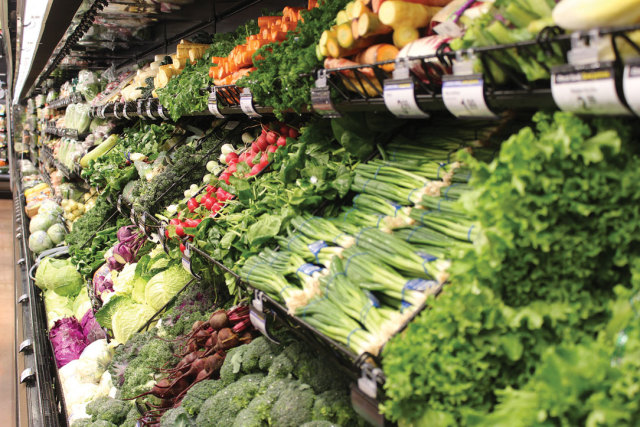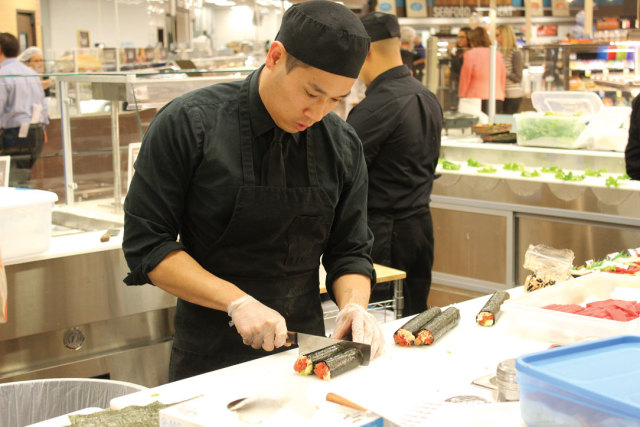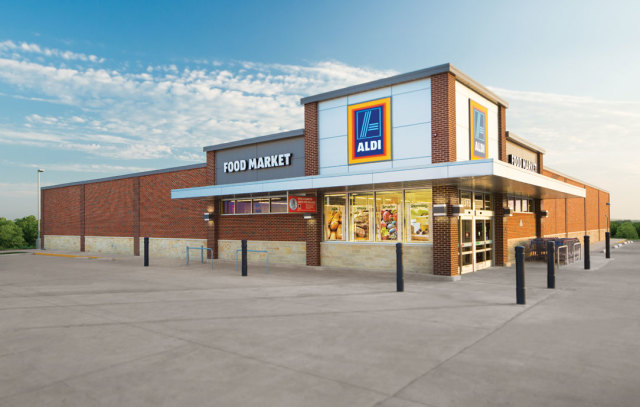The Grocery Store Wars Have Only Just Begun

Whole Foods on Post Oak has its own brewery.
Don’t tell anyone, but there’s a great new bar just north of the Galleria. It’s got 20 local beers on tap, a $10 steak night on Tuesdays, a crazy popular brunch on Sundays, a weekly trivia night and bingo, not to mention these great five-course dinner collaborations every month with 8th Wonder and other local brewers. Plus, you can take a growler of beer or bottle of wine to-go any time you want, because the bar—called, fittingly, The Bar—is inside a grocery store.
That store is the impressive Whole Foods Market on Post Oak Blvd., which opened last year, and The Bar is just one of its attractions. There are also free Saturday-morning yoga classes—picture 30 sun salutations framed beneath the store’s panoramic view of Uptown as the morning light streams in—a gourmet coffee shop, and an adorable little boutique offering jewelry, candles, casual clothing and other accessories.
Is it over the top? Absolutely. Unusual? Not these days. Houston’s grocery store chains are offering an ever-wider variety of products and experiences—yes, experiences—to shoppers, one-upping each other time again as they engage in a take-no-prisoners battle for Houstonians’ notoriously fickle supermarket dollars.

One small part of the produce section at Kroger
Image: Courtesy Kroger
“From a national perspective, Houston is one of the most competitive grocery markets in the country,” says Kristal Howard, public relations manager for Kroger Southwest. Why? Well, for one thing, we don’t have a dominant local supermarket brand, as most cities do. Technically, the top three grocers in the area are Walmart, H-E-B and Kroger respectively, but they’re really neck and neck, each occupying roughly a quarter of the overall market, according to industry publication The Shelby Report.
Next comes Fiesta, then Randall’s, which, during its heyday in the late 1990s, claimed 20 percent of the market, a number that has now dwindled to 6. The moral? Resting on your laurels is simply not an option when you’re a supermarket in Houston, where there’s always someone nipping at your heels. Among the challengers facing off against the big five right now are California-based Trader Joe's, Phoenix's Sprouts, North Carolina gourmet grocer Fresh Market, and Aldi, a discount German import.

Kroger employs a team of sushi chefs.
Image: Courtesy Kroger
Houston’s surging population has led to a wave of supermarket construction, from both leading and upstart chains, as retailers recover from their reluctance to build new stores during the recession. According to retail real estate brokerage Wulfe & Co., 32 new grocery stores will have opened by year’s end, collectively comprising 43 percent of the 3.71 million square feet of new retail space opening in 2015.
Given all that, you will be surprised to hear that when it comes to grocery stores, Houston has been underserved for years. According to a study by The Food Trust, a nonprofit group, the city has only 8.2 grocery stores per 100,000 people, significantly below the national average of 11.6. The dearth is particularly evident in our so-called food deserts, areas like Willowbrook, Sunnyside and the Near Northside, all of which have limited access to fresh produce.

Aldi is the new kid in town.
Image: Courtesy Aldi
Efforts at correcting this imbalance are ongoing, though progress is slow. In August, a new location of Houston-based Pyburns Fresh Farm Foods opened near NRG Stadium with the help of a partnership between the city and the Houston Grocery Access Task Force, a public-private organization that works to solve the food-desert problem. For the most part, however, the supermarket construction boom has served only to widen the divide between grocery haves and have-nots. Most of the new (and updated) stores can be found not in underserved neighborhoods but affluent areas like Tanglewood, Westchase, Upper Kirby and Montrose, which are already saturated with grocery options.
For shoppers in highly competitive neighborhoods, no amenity is spared. Four years ago, Inner Loopers delighted at the inviting beer and wine bar at Whole Foods on Waugh Dr. in Montrose, only to delight once more when the company upped the ante with its brewery at The Bar inside the Post Oak store, the first of its kind in the United States.
There was similar fanfare over the debut of the H-E-B Montrose on W. Alabama in 2011, with its sleek design courtesy of renowned Lake/Flato architecture firm, its live music on the patio and its popular twice-monthly food truck socials. The chain then topped itself this past February with its new H-E-B Tanglewood on San Felipe, which, at 91,000 square feet, is simply massive (though, to be fair, still not quite as monumental as the 127,000-square-foot H-E-B that opened off Bunker Hill Dr. in 2008). Every section is oversize, from the double-wide cosmetics aisle offering premium skincare products to the 1,600-bottle wine selection in the climate-controlled walk-in cellar. Indecisive types should avoid at all costs the yogurt wall, which spans a solid 20 feet and includes a staggering 498 varieties.
Of course, it seems there’s always something even more massive out there, namely the Kroger Marketplace stores in areas such as Richmond and Kingwood, which top out at about 120,000 square feet and stock everything from tufted sofas to truck tires. The chain, by the way, is spending $500 million over three years to open 12 new stores by the end of 2016 and remodel an additional 30 locations.
And as Kristal Howard notes, providing customers with a premium experience doesn’t mean just putting in craft beer bars. “We know customers don’t like waiting in line to purchase their groceries. A few years ago we installed a system and technology that helps to minimize a customer’s wait time and expedite their check-out experience,” she says of Kroger’s additional express lanes—installed especially at stores where younger shoppers are more likely to have short lists and light baskets—and an in-house system that monitors how busy each lane is, gathering data about peak hours and helping the stores staff intelligently to keep up.
The past decade has also seen consumers go from I’ll just grab lunch to-go from the salad bar to a full-on embrace of the grocery-store-as-restaurant, an evolution that has coincided with stores offering more and more prepared foods. This trend may have reached its apotheosis with the full-fledged Table 57 restaurant at H-E-B Tanglewood, which is outfitted with reclaimed wood accents and serves a menu designed by noted former Haven chef Randy Evans, complete with barbecue smoked in-store.
It's all designed to get more customers to spend more money, from Whole Foods’ offer to steam, season or blacken any fish from the counter for you a la minute to Kroger’s partnership with famed New York shop Murray’s Cheese, which lures shoppers into a decadent world of premium Manchegos and Bries.
Consumers, meanwhile, want more than super-sized shopping experiences. They want bargains. Enter Trader Joe’s, which bases its business model on offering house-brand versions of everything from grocery staples to gourmet items, and which opened the first of its five Houston stores in 2012. Aldi, the new kid on the block, debuted with nine Houston stores in 2013. Like its California counterpart, Aldi skips the frills and customizations of traditional grocers, opting instead to offer essentially the same lineup of 1,300 store-brand products in every one of its (relatively) petite 17,000-square-foot storefronts.
If there’s not an Aldi in your neighborhood yet, there probably will be soon: the company is opening around 10 stores per year in the greater metropolitan area, with plans for 30 in the next three years. And the chain’s not stopping there, aiming to eventually open 80 to 100 Houston stores in coming years, bringing them close to H-E-B in terms of market penetration. “There are several strong competitors here in Houston but what we do is very unique,” says Karla Waddleton, division VP for Aldi Rosenberg. “Houston being such a large market, it made sense to expand here. There are a lot of grocery dollars on the table.”
Meanwhile, Aldi and TJ’s both will see competition from Whole Foods’ new lower priced 365 by Whole Foods supermarkets, the first of its kind in Texas. The company plans to open five such stores in the Houston area; the first is slated for Garden Oaks sometime in the next couple of years.
Bottom line: the grocery wars aren’t coming to an end anytime soon. And whatever they’re looking for—low prices, endless options, new amenities or increasing convenience—Houstonians stand to be the real victors.
Ed. note: This story has been corrected from its original version, which mischaracterized the presence of Rice Epicurean Markets in Houston. There is a Rice Epicurean Market at 2020 Fountain View Dr. Houstonia regrets the error.




